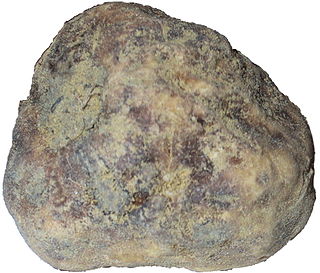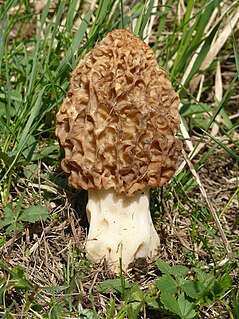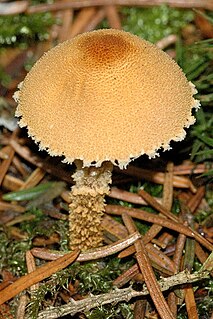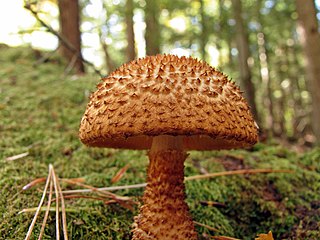
Clitocybe is a genus of mushrooms characterized by white, off-white, buff, cream, pink, or light-yellow spores, gills running down the stem, and pale white to brown or lilac coloration. They are primarily saprotrophic, decomposing forest ground litter. There are estimated to be around 300 species in the widespread genus.

Lepista is a genus of mushroom-forming fungi. According to the Dictionary of the Fungi, the widespread genus contains about 50 species. In 1969, Howard Bigelow and Alex H. Smith made the group a subgenus of Clitocybe.

The Pezizales are an order of the subphylum Pezizomycotina within the phylum Ascomycota. The order contains 16 families, 199 genera, and 1683 species. It contains a number of species of economic importance, such as morels, the black and white truffles, and the desert truffles. The Pezizales can be saprobic, mycorrhizal, or parasitic on plants. Species grow on soil, wood, leaves and dung. Soil-inhabiting species often fruit in habitats with a high pH and low content of organic matter, including disturbed ground. Most species occur in temperate regions or at high elevation. Several members of the Sarcoscyphaceae and Sarcosomataceae are common in tropical regions.

Gyromitra ambigua is an ascomycete fungus species of the genus Gyromitra, and related to the false morel G. esculenta. It belongs to the Pezizales order. The species is found in North America, where it produces fruit bodies (mushrooms) that grow on the ground. The edibility of the fruit bodies is not known with certainty, and it is not recommended for consumption.

Gyromitra caroliniana, known commonly as the Carolina false morel or big red, is an ascomycete fungus of the genus Gyromitra, within the Pezizales group of fungi. It is found in hardwood forests of the southeastern United States, where it fruits in early spring soon after snowmelt.

The Morchellaceae are a family of ascomycete fungi in the order Pezizales. According to a standard reference work, the family has contained at least 49 species distributed among 4 genera, but in 2012, 5 genera producing the sequestrate and hypogeous ascoma were added. The best-known members are the highly regarded and commercially picked true morels of the genus Morchella, the thimble morels of the genus Verpa, and a genus of cup-shaped fungi Disciotis. The remaining four genera produce the sequestrate fruit bodies.

The Pyronemataceae are a family of fungi in the order Pezizales. It is the largest family of the Pezizales, encompassing 75 genera and approximately 500 species. Recent phylogenetic analyses does not support the prior classifications of this family, and suggest that the family is not monophyletic as it is currently circumscribed.

The Carbomycetaceae are a family of fungi in the order Pezizales. The family contains the single genus Carbomyces, which in turn contains three species distributed in the USA and Mexico.

Scutellinia scutellata, commonly known as the eyelash cup, the Molly eye-winker, the scarlet elf cap, the eyelash fungus or the eyelash pixie cup, is a small saprophytic fungus of the genus Scutellinia. It is the type species of Scutellinia, as well as being the most common and widespread. The fruiting bodies are small red cups with distinct long, dark hairs or "eyelashes". These eyelashes are the most distinctive feature and are easily visible with a magnifying glass. The species is common in North America and Europe, and has been recorded on every continent. S. scutellata is found on rotting wood and in other damp habitats, typically growing in small groups, sometimes forming clusters. It is sometimes described as inedible, but its small size means it is not suitable for culinary use. Despite this, it is popular among mushroom hunters due to its unusual "eyelash" hairs, making it memorable and easy to identify.

Chorioactis is a genus of fungi that contains the single species Chorioactis geaster. The mushroom is commonly known as the devil's cigar or the Texas star in the United States, while in Japan it is called kirinomitake (キリノミタケ). This extremely rare mushroom is notable for its unusual appearance and disjunct distribution; it is found only in select locales in Texas and Japan. The fruit body, which grows on the stumps or dead roots of cedar elms or dead oaks, somewhat resembles a dark brown or black cigar before it splits open radially into a starlike arrangement of four to seven leathery rays. The interior surface of the fruit body bears the spore-bearing tissue known as the hymenium, and is colored white to brown, depending on its age. The fruit body opening can be accompanied by a distinct hissing sound and the release of a smoky cloud of spores.

Urnula is a genus of cup fungi in the family Sarcosomataceae, circumscribed by Elias Magnus Fries in 1849. The genus contains several species found in Asia, Europe, Greenland, and North America. Sarcosomataceae fungi produce dark-colored, shallow to deep funnel-shaped fruitbodies with or without a stipe, growing in spring. The type species of the genus is Urnula craterium, commonly known as the devil's urn or the gray urn. Urnula species can grow as saprobes or parasites having an anamorphic state. The anamorphic form of U. craterium causes Strumella canker, on oak trees.

Caloscypha is a fungal genus in the family Caloscyphaceae. A monotypic genus, it contains the single species Caloscypha fulgens, commonly known as the spring orange peel fungus, the golden cup, or the dazzling cup. It is a cup fungus, typically up to 4 centimetres (1.6 in) in diameter, with a bright to pale orange interior and orange; specimens that are old or bruised often have an olive-green discoloration, especially around the edges. In North America, it is usually found on the ground in forest litter near conifers. Fruiting occurs in early spring following snow melt. The asexual (imperfect), or conidial stage of C. fulgens is the plant pathogenic species Geniculodendron pyriforme, known to infect dormant seeds of the Sitka spruce.

Pseudoplectania is a genus of fungi in the family Sarcosomataceae. The genus contains 12 species. Pseudoplectania ryvardenii was described in 2012, while Pseudoplectania carranzae was transferred to the genus in 2013.

Leucopholiota is a genus of fungi in the mushroom family Tricholomataceae. It consists of the species Leucopholiota decorosa and Leucopholiota lignicola.

Cystoderma is a genus of fungi in the family Agaricaceae or Cystodermataceae. Its family position is in doubt and the family "Cystodermataceae" and tribe "Cystodermateae" have been proposed to include this group following recent molecular work.

Cystodermella is a genus of fungi in the family Agaricaceae. The genus comprises about 12 species, noted for producing agaric fruit bodies, bearing a cap, white gills and stipe with a fine, ephemeral ring. The genus was devised by Harri Harmaja in 2002, dividing the older genus Cystoderma into three independent genera: Cystoderma, Ripartitella and Cystodermella largely on the basis of microscopic differences. Cystodermella species bear non-amyloid spores and sometimes cystidia. The spores, in contrast to Ripartitella are not echinulate.

Leucopholiota decorosa is a species of fungus in the mushroom family Tricholomataceae. Commonly known as the decorated pholiota, it is distinguished by its fruit body which is covered with pointed brown, curved scales on the cap and stem, and by its white gills. Found in the eastern United States, France, and Pakistan, it is saprobic, growing on the decaying wood of hardwood trees. L. decorosa was first described by American mycologist Charles Horton Peck as Agaricus decorosus in 1873, and the species has been transferred to several genera in its history, including Tricholoma, Tricholomopsis, Armillaria, and Floccularia. Three American mycologists considered the species unique enough to warrant its own genus, and transferred it into the new genus Leucopholiota in a 1996 publication. Lookalike species with similar colors and scaly fruit bodies include Pholiota squarrosoides, Phaeomarasmius erinaceellus, and Leucopholiota lignicola. L. decorosa is considered an edible mushroom.
Donadinia is a genus of fungi in the family Sarcosomataceae. It contains the species Donadinia sibirica from Russia, and Donadinia seaveri, found in Bermuda.

Otidea is a genus of fungi in the family Pyronemataceae. The genus is widely distributed in northern temperate regions.

Rhododendron columbianum, commonly known as western Labrador tea, swamp tea, or muskeg tea, is a shrub that is widespread in the western United States and in western Canada, reported from British Columbia, Alberta, Washington, Oregon, Idaho, California, Montana, Wyoming, Utah, Nevada, and Colorado. It grows in wet places from sea level up to 3,500 m (11,000 ft). It was formerly known as Ledum columbianum. Its origins date back to the late Pliocene.



















